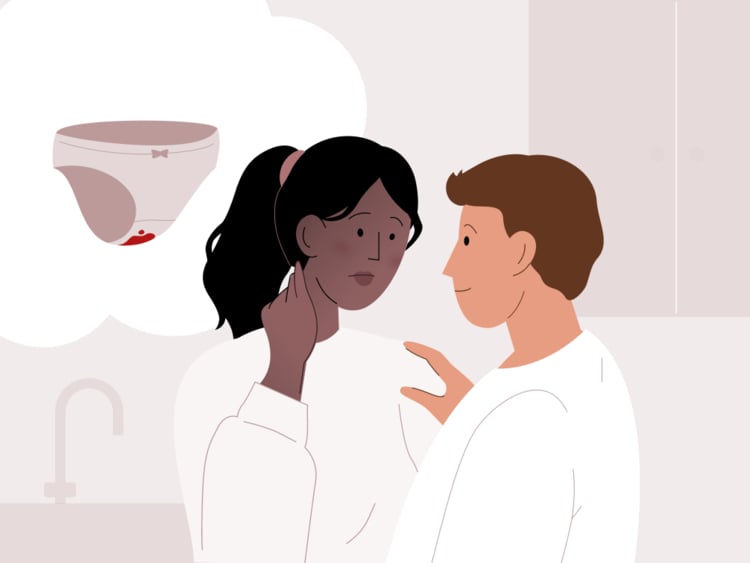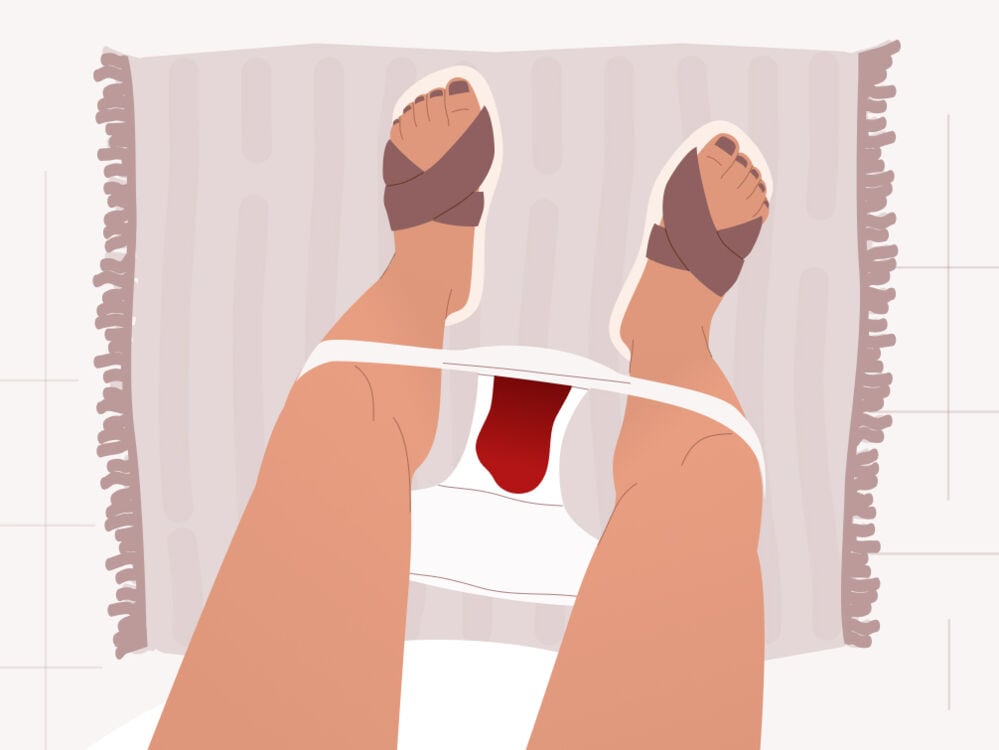If you’re trying for a baby, finding blood in your underwear can be understandably upsetting. A doctor explains how to tell the difference between a period and a miscarriage.
-
Tracking cycle
-
Getting pregnant
-
Pregnancy
-
Help Center
-
Flo for Partners
-
Anonymous Mode
-
Flo app reviews
-
Flo Premium New
-
Secret Chats New
-
Symptom Checker New
-
Your cycle
-
Health 360°
-
Getting pregnant
-
Pregnancy
-
Being a mom
-
LGBTQ+
-
Quizzes
-
Ovulation calculator
-
hCG calculator
-
Pregnancy test calculator
-
Menstrual cycle calculator
-
Period calculator
-
Implantation calculator
-
Pregnancy weeks to months calculator
-
Pregnancy due date calculator
-
IVF and FET due date calculator
-
Due date calculator by ultrasound
-
Medical Affairs
-
Science & Research
-
Pass It On Project New
-
Privacy Portal
-
Press Center
-
Flo Accuracy
-
Careers
-
Contact Us
How to tell the difference between a miscarriage and a period


Every piece of content at Flo Health adheres to the highest editorial standards for language, style, and medical accuracy. To learn what we do to deliver the best health and lifestyle insights to you, check out our content review principles.
If you’re at the stage of your cycle where your period is due, and you’re either trying for a baby or think you might already be pregnant, seeing blood in your underwear can bring up a whole host of emotions. You may be wondering whether that blood is a sign of early pregnancy bleeding (such as implantation bleeding), an early miscarriage, or whether it’s your period. As a result, it’s totally natural to find yourself assessing the consistency and color of the blood to see if it’s any different from your usual period.
It’s completely understandable to feel this way. Wherever you are in your fertility journey, it can be a difficult and anxiety-inducing time. But to help provide some answers and hopefully some reassurance too, we’ve spoken to Dr. Amanda Kallen, associate professor of obstetrics, gynecology, and reproductive endocrinology at the Yale University School of Medicine, Connecticut, US, for her guidance.
What’s the key way to tell the difference between a miscarriage vs a period?
We know how distressing it can feel to see blood or spotting in your underwear when you’re trying for a baby or if you think you might already be pregnant but haven’t yet taken a pregnancy test. Unfortunately, at this early stage, it can be almost impossible to tell the difference between a period and an early miscarriage (which is called a chemical pregnancy if it happens within the first five weeks of pregnancy).
As Dr. Kallen explains: “The symptoms [at this stage of your cycle] between a period and a chemical pregnancy are very similar.” These symptoms can include vaginal bleeding and cramps; we’ll share more on that later. It’s very frustrating to hear that there are so many overlaps between an early-stage miscarriage and a period, especially when they mean such different things. But there are some steps you can take to try to get to the bottom of what’s going on.
The first thing Dr. Kallen advises is to take a pregnancy test. You can still take a pregnancy test even if you’re currently bleeding. If the test comes up negative, then you should assume the bleeding is your period. If this is the case, but the bleeding you’re experiencing feels different from normal (such as if it’s heavier or lighter or the bleeding is irregular), then it’s probably wise to speak to your doctor to make sure everything is OK.
If the test comes up positive, then try not to panic. Bleeding during pregnancy can be a scary thing to experience, but it doesn’t necessarily mean that you’re having a miscarriage. Spotting (light bleeding) is actually a common early sign of pregnancy. “Bleeding in pregnancy is very common,” Dr. Kallen reassures; between 15% and 25% of people will experience bleeding during their first trimester. You could be experiencing implantation bleeding, which happens when the embryo burrows into the lining of your uterus.
However, there’s also the possibility that the bleeding could be a chemical miscarriage. If you think this might be the case, then speak to your doctor for guidance and advice.
Remember, the crucial thing when determining whether you’re experiencing a miscarriage or period is to take a pregnancy test. “If a pregnancy test hasn’t been taken, then there’s no concrete way to tell whether the bleeding was a chemical pregnancy or if it’s your regular period,” explains Dr. Kallen. As always, if you have any concerns at all, then contact your doctor.
Signs of a period
Now that we can see how difficult it is to distinguish between a miscarriage or a period without taking a pregnancy test, let’s look at some of the signs you might be having your period.
Our bodies are all different, so it makes sense that our menstrual cycles are, too. A period can happen every 28 days or so, but research carried out in collaboration with Flo found that only 16% of women reported a cycle of this length. Instead, experts consider anything ranging from 21 to 35 days as a normal length for a menstrual cycle.
Bleeding is one of the main signs of your period arriving. This will generally last between two and seven days — it differs from person to person and even from period to period. The color can also vary; it can be anything from red, when the bleeding is at its heaviest, to brown, when it is slightly lighter. Some people will have heavier bleeding than others; you’ll know what’s normal for you, but generally, you’ll lose around 30 to 72 ml of blood (that’s roughly the equivalent of about 5 to 12 teaspoons). You might also experience period blood clots if you have a heavier flow.
Other signs of your period can include:
- Menstrual cramps — You’ll likely feel those familiar cramping pains in your lower abdomen in the days leading up to and during your period.
- Premenstrual syndrome — This is a common condition that’s thought to affect around 3 out of 4 menstruating people. The symptoms can include acne, bloating, mood swings, fatigue, and a low sex drive.
- Food cravings — Do you have a sudden craving for chocolate, carbs, and sweet drinks around the time of your period? We hear you. Research suggests these types of cravings are due to the hormonal changes that happen during this time.
Of course, not every person will experience the same signs and symptoms of a period. You will know what’s normal for you, and if you have any concerns, then it’s important to reach out to your health care provider.
However, you should always reach out to your doctor if you “are bleeding through a pad every hour, are experiencing new, heavy, or ongoing bleeding, severe pain, cramping, dizziness, fainting, chills, or a fever,” advises Dr. Kallen. Your doctor could also help you determine whether your bleeding is your period, implantation bleeding, or a miscarriage.

Signs of miscarriage
So how can the signs of a miscarriage differ from that of a period? Similarly to a period, Dr. Kallen explains that the symptoms of a miscarriage in the first trimester “include bleeding (heavy or light), cramping, and/or pain. Symptoms can vary quite a bit, from quite significant cramps to few or no bleeding at all.”
If you’re experiencing a chemical pregnancy, you may have heavier bleeding with blood clots or more intense cramps than your usual period. There is no medical treatment for a chemical pregnancy, although you might wish to speak to your doctor for advice and reassurance.
It’s completely understandable to see a chemical pregnancy as a loss and to feel sadness, grief, and anxiety. “It can be a roller coaster of physical and emotional symptoms,” explains Dr. Kallen. She says that you may “feel grief, numbness, anxiety, sadness, and find you have trouble sleeping or eating” after a chemical pregnancy or later miscarriage. Equally, she adds that “you may not feel sad at all.” There are no right or wrong feelings.
It might also help to remember that the likelihood of recurrent miscarriages is very small; only 1% of people will experience repeated miscarriages. If you do experience more than one miscarriage, it could help to reach out to a reproductive endocrinologist for their advice.
How long after a miscarriage do you get your period?
As all of our cycles vary, so too can the timing of the arrival of your period after a miscarriage. “We usually say 4 to 6 weeks,” says Dr. Kallen. “It really depends on how far along the pregnancy was.”
It’s possible to get pregnant again as soon as two weeks after a miscarriage. If you don’t want to get pregnant right away, however, and instead want to take some time to recover emotionally and physically, you might wish to consider using birth control. You may also want to wait until after you’ve had your next period to start trying again so that you can track your cycle with an app like Flo. It’s an incredibly personal decision, and there is no right or wrong time to try for another baby if that’s what you decide to do.
The takeaway: How to tell the difference between a miscarriage vs a period
As we’ve seen, the symptoms of a miscarriage vs a period are very similar, particularly in the five weeks after your last period. The key way to tell the difference is whether you’ve had a positive pregnancy test or not. Remember that some mild or moderate bleeding and pain are common in early pregnancy, so experiencing these symptoms doesn’t necessarily mean you’re having a chemical pregnancy or miscarriage. However, if you have any concerns at all, always reach out to your health care provider.
Most importantly, if it turns out you have experienced a pregnancy loss, be kind to yourself and reach out for support if you need it. “It’s important to take time and space for yourself to grieve as you need it — no matter how far along your pregnancy was at the time of the miscarriage. Be gentle, and don’t blame yourself,” reassures Dr. Kallen.
“Ask for support from loved ones and trusted friends,” she continues. “Counseling and support groups are great resources. If you’re planning to try to conceive again, talk to your doctor about timing and whether any other testing might be needed before you do.”


Hey, I'm Anique
I started using Flo app to track my period and ovulation because we wanted to have a baby.


The Flo app helped me learn about my body and spot ovulation signs during our conception journey.


I vividly
remember the day
that we switched
Flo into
Pregnancy Mode — it was
such a special
moment.
Real stories, real results
Learn how the Flo app became an amazing cheerleader for us on our conception journey.
References
“Bleeding during Pregnancy.” The American College of Obstetricians and Gynecologists, www.acog.org/womens-health/faqs/bleeding-during-pregnancy. Accessed 22 Dec. 2022.
“Chemical Pregnancy.” Cleveland Clinic, my.clevelandclinic.org/health/diseases/22188-chemical-pregnancy. Accessed 22 Dec. 2022.
“Early Pregnancy Loss.” The American College of Obstetricians and Gynecologists, www.acog.org/womens-health/faqs/early-pregnancy-loss. Accessed 22 Dec. 2022.
Hendriks, Erin, et al. “First Trimester Bleeding: Evaluation and Management.” American Family Physician, vol. 99, no. 3, Feb. 2019, pp. 166–74.
“Implantation Bleeding: Common in Early Pregnancy?” Mayo Clinic, 19 Apr. 2022, www.mayoclinic.org/healthy-lifestyle/pregnancy-week-by-week/expert-answers/implantation-bleeding/faq-20058257.
“Overview: Periods.” NHS, 2020, www.nhs.uk/conditions/periods/.
“Menstrual Cycle: What’s Normal, What’s Not.” Mayo Clinic, 6 Dec. 2022, www.mayoclinic.org/healthy-lifestyle/womens-health/in-depth/menstrual-cycle/art-20047186.
“Menstrual Cramps.” Mayo Clinic, 30 Apr. 2022, www.mayoclinic.org/diseases-conditions/menstrual-cramps/symptoms-causes/syc-20374938.
“Miscarriage.” Mayo Clinic, 16 Oct. 2021, www.mayoclinic.org/diseases-conditions/pregnancy-loss-miscarriage/symptoms-causes/syc-20354298.
Krishnan, Sridevi, et al. “Menstrual Cycle Hormones, Food Intake, and Cravings.” The FASEB Journal, vol. 30, suppl. 1, Apr. 2016, doi.org/10.1096/fasebj.30.1_supplement.418.6.
“Premenstrual Syndrome (PMS).” Mayo Clinic, 25 Feb. 2022, www.mayoclinic.org/diseases-conditions/premenstrual-syndrome/symptoms-causes/syc-20376780.
“Repeated Miscarriages.” The American College of Obstetricians and Gynecologists, www.acog.org/womens-health/faqs/repeated-miscarriages. Accessed 22 Dec. 2022.

